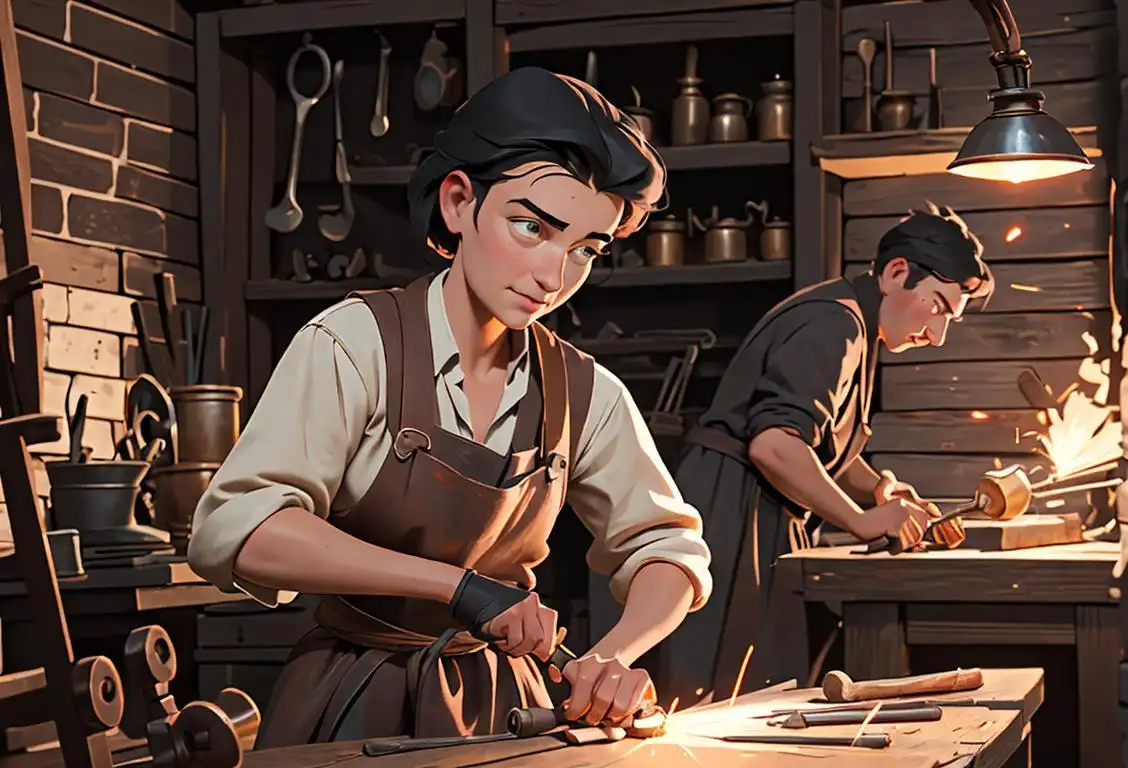National Smith Day

Who doesn't love a good old Smith? Whether it's the last name of your favorite actor or simply the friendly neighborhood blacksmith who keeps you well-equipped with horseshoes, National Smith Day is here to celebrate all things Smithy! Get ready to learn about the internet history and the notable mentions of this special day.
When is Smith Day?
It's national smith day on the 6th January.
The Origins of National Smith Day
Did you know that National Smith Day was first mentioned online on January 6, 2016? That's right, folks! It seems like people couldn't wait to show their appreciation for the hardworking Smiths of the world. They wanted a day solely dedicated to honoring all the Smiths and recognizing their contributions to various fields, from metallurgy to acting. Because, let's be honest, who can resist the charms of Will Smith or Maggie Smith?Notable Smithy Moments in History
While the origins of National Smith Day may be shrouded in mystery, the legacy of Smiths throughout history is not. From the iconic blacksmiths of the Middle Ages to the illustrious Smith families making their mark in showbiz, the name Smith holds a special place in our hearts.To commemorate National Smith Day, let's take a stroll down history lane and appreciate some notable Smiths:
- John Smith: This English explorer played a significant role in the colonization of Jamestown, Virginia. He even had a Disney movie made about him!
- Joseph Smith: The founder of the Church of Jesus Christ of Latter-day Saints, also known as the Mormon Church. He had quite the impact!
- Robert Smith: Not to be confused with the lead singer of The Cure, this Robert Smith was the Secretary of State under President James Madison. Talk about politics!
A Fun Fact About Smiths
Did you know that Smith is one of the most common surnames in the English-speaking world? It's right up there with names like Johnson, Miller, and Williams. So the next time you meet someone with the last name Smith, remember that you might just be encountering a descendant of the mighty blacksmiths of yore. Carry this knowledge with pride and fascination!History behind the term 'Smith'
1100s
Origins in Medieval Europe
The term 'smith' originated in Medieval Europe during the 1100s. It comes from the Old English word 'smithe' which means 'to strike' or 'to smite.' At this time, a 'smith' referred to someone who worked with metal, particularly blacksmiths who shaped and forged iron and steel by hammering them.
Old English (around 900)
The Origins of the Term 'smith'
The term 'smith' is derived from the Old English word 'smithe,' which means 'to strike.' In ancient times, it referred to a person who worked with metal, particularly iron. These skilled craftsmen were highly valued in their communities due to their ability to create tools, weapons, and other essential metal objects.
1000 AD
Origin of the word 'smith'
The term 'smith' is derived from the Old English word 'smythe,' which means 'one who works with metal.' This word can be traced back to the Proto-Germanic word 'smiþaz,' which has the same meaning. It was commonly used to refer to individuals who worked with iron and other metals to create tools, weapons, and various metal objects.
12th-14th centuries
The rise of blacksmiths
During the 12th to 14th centuries, blacksmithing emerged as an essential craft. Blacksmiths were highly skilled metalworkers who specialized in forging iron and steel. They played a crucial role in medieval society, creating weapons, armor, and tools. The term 'smith' became closely associated with the blacksmith profession due to their prominence and widespread presence in communities.
1200s
Rise of Guilds and Smithing Professions
During the 1200s, guilds started appearing across Europe. These were associations of craftsmen and artisans who held a monopoly on their respective trades. The smithing professions, including blacksmiths, goldsmiths, and silversmiths, were highly valued and became integral parts of these guilds. Guild membership ensured quality craftsmanship and protected the interests of the smiths.
Medieval Times (10th - 15th centuries)
Blacksmiths: The Prominent Metalworkers
During the medieval era, blacksmiths emerged as the most prominent type of smith. They specialized in shaping and forging iron, using techniques such as heating and hammering to create various metal items like armor, horseshoes, and tools. Blacksmiths played a vital role in the feudal system and were highly respected for their craftsmanship.
18th century
Expansion to other metalworking fields
In the 18th century, the term 'smith' expanded its meaning to include other metalworking professions. For instance, silversmiths specialized in working with silver, goldsmiths with gold, and locksmiths with locks and keys. This broader usage of the term 'smith' reflected the diverse range of skilled metalworkers who were involved in crafting and shaping metals.
1500s
Expansion and Specialization
The 1500s saw the expansion and specialization of the smithing professions. As various metalworking techniques advanced, more specific branches of smithing emerged. Bladesmiths focused on crafting swords, knives, and other sharp-edged weapons. Gunsmiths arose with the development of firearms. Locksmiths honed their skills in creating intricate locks and keys. This specialization led to higher levels of expertise among smiths.
17th - 18th centuries
Expanding Specializations: Goldsmiths and Silversmiths
As trade and craftsmanship continued to evolve, new specializations of smiths emerged. Goldsmiths and silversmiths became prominent during this period, focusing on working with precious metals. These skilled artisans were responsible for creating intricate jewelry, exquisite silverware, and decorative objects. Their expertise was sought after by the upper classes for their ability to create highly detailed and valuable pieces.
1700s
Industrial Revolution and Technological Advancements
With the onset of the Industrial Revolution in the 1700s, traditional manual smithing methods gave way to mechanization and modern manufacturing techniques. The advent of steam power and mass production revolutionized the manufacturing processes across various industries. This period marked a significant shift from the individual craftsmanship and guild-based smithing to industrial scale production.
19th century
Industrial Revolution: Rise of Machine-Forged Products
With the advent of the Industrial Revolution, the role of the smith underwent a significant transformation. Traditional handcrafting methods were gradually replaced by machine-driven production. The term 'smith' expanded to include individuals working in mass production industries, such as factory workers involved in metalworking processes. This shift marked a turning point in the history of smiths, as the focus shifted from individual craftsmanship to efficient production.
19th century
Industrial revolution and modernization
With the advent of the industrial revolution in the 19th century, the role of the 'smith' transformed significantly. Traditional handcrafted metalworking gave way to mechanized production methods. The term 'smith' became more associated with machine operators, like blacksmiths who operated power hammers, rather than individual craftsmen. This shift marked the modernization of metalworking industries and the changing perception of the term 'smith.'
Present day
Smith as a common surname
Over time, 'smith' became one of the most common surnames across English-speaking countries. This is due to the widespread use and association of the term with the metalworking profession throughout history. The surname 'Smith' is considered a 'occupational surname' and is often passed down through generations, serving as a lasting reminder of the cultural impact and historical significance of the term 'smith.'
1900s
Smithing in Modern Times
In the modern era, the term 'smith' still holds relevance, but its meaning has expanded beyond metalworking professions. Today, it is commonly used as a suffix attached to various occupations, signifying a skilled worker or practitioner in a specific field. For example, words like wordsmith (a skilled writer), goldsmith (a person who works with gold), and blacksmith (an expert in traditional ironwork) continue to preserve the legacy of the term.
20th century to Present
Expanding Definition: Modern Smiths
In the modern era, the term 'smith' has diversified even further. The concept of a 'smith' expanded beyond traditional metalworking trades to encompass a wide range of professions. For example, wordsmiths refer to individuals skilled in the use of language, locksmiths specialize in locks and security systems, while blacksmiths continue to preserve the craft of shaping metal by hand. The term 'smith' retains its historical connections with craftsmanship, but with a more diverse and expanded definition.
Did you know?
Did you know that Smith is one of the most common surnames in the English-speaking world?Tagged
fun history recognizeFirst identified
6th January 2016Most mentioned on
6th January 2016Total mentions
14Other days
Smith Day
Maritime Day
Memorial Day
Video Game Day
Liberation Day
Teacher Appreciation Day
Vodka Day
Former Prisoner Of War Recognition Day
Flag Day
Convention Day








